 |
 |
|
 |
 |
The Military History of the Gannans
When did it start
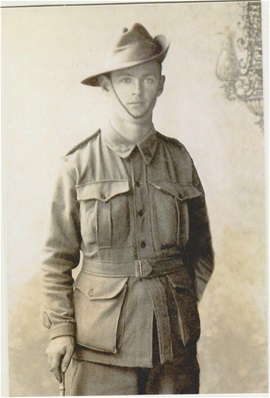 Jim Gannan on his return to Australia after being wounded in France in August 1916
Jim Gannan on his return to Australia after being wounded in France in August 1916
Our involvement in the Military affairs of Australia began soon after Great Britain Declared War on Germany on 4 August 1914, as did every Dominion and Colony in the British Empire. The Commonwealth
of Australia declared War on Germany, in support of Great Britain on the 5th of August 1914. Australia offered the British 20,000 troops "of any desired combination to any desired location required by the Home Government and to be at the complete disposal
of the Home Government". General Bridges was given the task of equiping and training 20,000 men which he completed by 21 September1914. This force was known as the 1st Division and the 1st Light
Horse of the Australian Imperial Force(AIF). The young men who rushed to join the AIF came from all walks of life and represented a wide cross section of Australian men. These men all had zest for life and adventure. By 21 September, 12 Battalions of Infantry, 3 Regiments of Light Horse and the Artilery and other units required to support this force were embarked upon their various transports and set sail for Albany, WA. These ships
were assembled at King George Sound near Albany on 24 October, refueled and replenishing for the long haul to Eygypt. At 8.55am on 1 November 1914 the first of 36 transports weighed anchor and followed by the rest, set sail. The adventure had begun.
James Alan Gannan At the age of 21 years and 1 month Jim gave up being a bank clerk and enlisted in
the AIF, on 8 July 1915. He had heard the Bugle Call sometime earlier and had been rejected for service due to a Strained Heart. Initially there were so many young men trying to enlist in the AIF at the time that only those with perfect health were accepted.
Shortly afterwards the Medical Restrictions were eased and many of those previously rejected were enlisted, including one James Gannan. The enlistment centre in those days was set up at the
MCG. From there the men were taken to Broadmeadows Army Camp. At Broadmeadows the men were issued with their new kit and shown their new accomodation. For the next three months the men were kept in camp, being trained to do such things as dress like a soldier,
wear their hat and most importantly how to use their weapons. Oh, and march. Route marches of ten to twenty miles per day were not uncommon. Cleaning brass and polishing boots was also high on the training list.
To Egypt
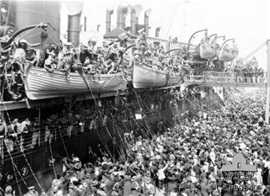 HMAT Nestor at Port Melbourne with soldiers and a huge crowd to see them off at Port Melbourne on 2 Oct 1915
HMAT Nestor at Port Melbourne with soldiers and a huge crowd to see them off at Port Melbourne on 2 Oct 1915
After embarking on HMAT Nestor, the ship departed the Port of Melbourne and headed to Adelaide and finally Albany before leaving Australia for Egypt. The ship sailed through the Suez Canal and arrived in
Egypt at Alexandria on 22 Feb 1916. The 11th and 12th Re-enforcements consisting of 2 Officers and 482 Other Ranks, including one Private JA Gannan, joined the 5th
Bn AIF at Serapeum that day, 22 Feb, after a long march from the Port of Alexandria. The 5th Bn was located in an area known as the Canal Zone. The unit was training for its next deployment in France. At this base the Battalion was trained in musketry,
grenade throwing and bayonet fighting. Other activities included Sandbag filling, trench digging, erection of barbed wire entanglements (fences) and on occasion marching and some leave. On 10 March,
the Battalion, handed over its trenches to the 8th Light Horse and moved to a staging camp at Serapeum. A Battalion Parade was called for the 15th and as it was a Farewell Parade it was reviewed by Major General Chauvel. The next major
activity was a battalion innoculation parade on the 18th to protect the soldiers against Typhoid. To top this off on the next day His Royal Highness, the Prince of Wales and Six Generals and their attending Staff rode through the Camp, much to the
delight of the soldiers, I’m sure. This was followed by a muster parade, which everyone must attend, to have nominal rolls finalised and a Kit Check to ensure all soldiers had the correct and serviceable equipment for their service in France.
To France
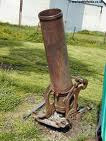 Stokes Trench Mortar
WWI
Stokes Trench Mortar
WWI
5 Battalion embarked on the Navy Ship HMT Briton around 0800 hours on 25 March 1916 at Alexandria and disembarked at Marseilles in France at 1830 hours on 30 March. The next day at 1130
the Battalion boarded a train for a place called Godwaetsveldt. Some 60 hours later they arrived, detrained and camped (bivouacked) for the night. Compared to Egypt this place was very cold. They shivered through the night and at 0630 hours they commenced
their march to their next destination, Steent-te Village, 13 Miles (20klm) away. Six hours later they were dismissed to their allocated billets where they spent the rest of the day cleaning up and making the place habitable. On the 14th and 15th the Unit was moved to a new area, this time a Fort Rompul, not too far away.
A Month of Training
 Lewis Machine Gun
WWI Infantry Section Machine Gun
Lewis Machine Gun
WWI Infantry Section Machine Gun
While the 5th Battalion was at both Steent-te Village and Fort Rompul, Officers and NCOs were sent to various local training schools to brush up on their skills and learn some new ones. These
were taught at such places as Trench Mortar School, Physical and Bayonet Fighting, Machine Gun schools. These men then returned to their units and taught and practiced the men in these skills. Time was spent at the Grenade and Rifle Ranges. At times when there
was a break in the program, and the men appeared to be doing nothing, a route march of anything up to 20 miles was considered as good training. Can’t have the men sitting around, you know! A highlight of this time was a route march to the 7 Battalion
area for Gas training. This training consisted of lectures and demonstrations. What the gas did to you, how to protect yourself from the gas threat and importantly how to wear a gas mask or cape. This would have been practiced at great length until some
officer considered you were proficient at wearing the same. Finally there would be a test, first, into a shed or trench with your masks on, and wait for it! A gas bomb was tossed into the trench. This was generally followed, after an appropriate time, “Masks
Off!!!” and another bomb chucked in just to show the difference between wearing or not wearing a gas mask during a gas attack. Once the coughing and spluttering had subsided, the Battalion was lined up and marched back to their billets.
The Front Line
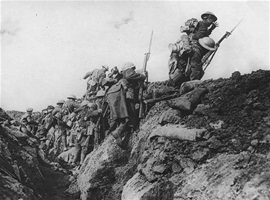 Bayonet Charge
Bayonet Charge
On 30 April 1916, 5 Battalion occupied frontline trenches in what was known as the Fleurbiax Sector, or Fromelles as it is rightly called. Here was learnt the art of Trench Warfare. Keeping trenches clean and in good repair,
manning listening posts and providing ration parties and any other job that could be thought of to keep the men busy. The ration parties were required to follow the communications trenches to the place where the
supply wagons bought their loads. From this dump the men loaded rail wagons and then push them along a wooden rail line across open country, back to the trenches. These men were often exposed to rifle and machine-gun fire, making them a rather unhappy party.
The enemy was also kind enough to disturb the peace with Artillery fire which was enthusiastically answered by our 2nd Division Gunners. There was a gas attack on the line but no damage was done. On the 13th May the Battalions fourteen days on the front line were over and they were relieved by 7 Battalion. The casualties for that first fortnight were five killed and 20 wounded. Back in reserve the normal life of the infantryman returned. Work Parties with much digging and carrying for the Engineers. The keeping of trenches and accommodation clean, in good order, the rush for the trenches whenever the Artillery of both sides
got active. These things kept the soldiers of 5 Battalion busy for the next 13 days. On the 27th of May the unit relieved 7 Battalion in the trenches. The 7th Bn reported that enemy activity had
increased and warned the 5th to be on their toes. During daylight hours things were rather boring, however once it got dark, activity on both sides of the battlefield increased. Patrols were sent out, listening posts set and work parties going about
their business. At this stage it appears that when the Australians Patrols etc returned to their trenches, the Germans sent out theirs to patrol, set up listening posts and get the working parties active. It has to be said that as the soldiers of both sides
ventured into that area known as “No Mans Land” their activities were interrupted by machine gun, and at times, Artillery fire. On the 10th of June the Battalion was relieved and billeted in
farmhouses at Le Nouveau Monde. Here work consisted of four hours training in the morning and the afternoon was free to do as the soldiers liked. Soldiers took this opportunity to venture far and wide to see as much of the county as possible. This was greatly
appreciated by the men until, on the 20th of Jun the Battalion was ordered to Neuve Eglise, over the Belgian Border. Here they were billeted in tents before being moved on to Ploegsteert Wood, belonging to the King of Belgium. On the 12th
of July the Battalion moved towards the Somme.
Pozieres
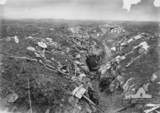 Captured German Trench at Pozieres
Captured German Trench at Pozieres
The unit marched to Albert and bivouacked in a field. On the 20th of July movement to the front line was completed. Evidence of the struggle was all around. The area was pitted with artillery shell craters, abandoned
equipment and arms, horribly decomposed bodies, shattered timber and ruined dugouts marked the passage of war. The 24th saw the unit move to the front line trenches at Pozieres. 25th of July
saw the Battalion attacking and capturing its first objective, an Old German trench called O.G.1. 5 Battalion moved onto its next objective, O.G.2. which it took but lost again due to a ferocious counter attack by the German defenders. The Australians
consolidated their position in O.G.1. Casualties for the day were 6 Officers and 39 Other Ranks Killed in Action(KIA), 6 Officers and 242 Other Ranks Wounded in Action(WIA) and 1 Officer and 155 Other Ranks Missing in Action. A total casualty list of 13 Officers
and 436 Other Ranks for the effort. The battalion was relieved in the front line on 27th July and returned to Albert. On 31 July the Battalion was in reserve at Bonneville. Its effective strength was 25 Officers and 569 Other Ranks, down from 35
Officers and 1002 Other Ranks on 14th of July. By August the 7th the Battalion had been reinforced and moved to Vandencourt Wood. More training a visit by His Majesty The King kept the soldiers
occupied until the 14th when they were returned to the old German lines at La Boselle. On the 16th the men were in the front line trenches at Pozieres. On this day 7 Other Ranks were wounded. On 17th August two companies were
relieved in the frontline after suffering 2 Officers and 48 Other Ranks WIA. A working party of 2 Officers and 155 Other Ranks were preparing a “Jumping Off” trench. Heavy shelling by enemy artillery and machine gun fire during the day and overnight
on the 18th resulted in 1 Officer and 30 Other Ranks KIA and 1 Officer and 89 Other Ranks WIA. One of those WIA was Pte James Gannan. Here we leave 5 Battalion AIF and follow Jim through the remainder
of his service.
Wounded
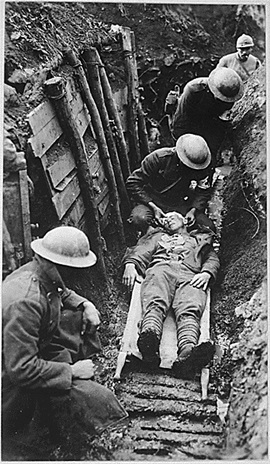 A Casualty awaiting evacuation from the forward trench back to a CCS
A Casualty awaiting evacuation from the forward trench back to a CCS
Private J.A. Gannan was wounded at Pozieres on 18 August 1916. All casualties are removed from the Battlefield to a unit behind the front line called a Casualty Clearing Station (CCS). Here the wounded
are treated and assessed as to what happens next. In Jims case the wound was considered serious enough for him to be evacuated further back to the 1st Canadian General Hospital located at Etaples on 21 Aug. On 26 Aug 13 Field Ambulace took over
and transported Jim, along with many other wounded soldiers, to Calais. They were embarked upon the Hospital Ship Brighton and from there to England and the Norfolk War Hospital on 27 Aug 1916. Eventually, considered fit enough to be returned to Australia,
he was transferred to 1st Australian Auxilluary Hospital at Harefield on 22 Nov. His next move was to Plymouth to Embark on the Hired Transport (H.T.) Benalla on 13 Feb 1917. The record shows Jim landed in Australia on the 10th of April and was
discharged from the Austrtalian Imperial Force on the 6th of June 1917 as unfit for further service due to his wound. For his effort he was awarded th 1914-15 Star, British War Medal and the Victory
Medal.
Credits
All the information given in this piece is a matter of public record. Information was gathered from the Australian War Memorial Site, National
Archives and various free photographic sites including Getty images. Unit War Diaries of 5 Battalion AIF, 1 Division AIF and a book called Forward with the Fifth provided much of
the information I required. This page was very interesting during the research stage and I found myself being sidetracked by other bits of information. Sorry it took so long. The next soldier
is Jims brother, Gerald Allan Gannan, better known as Uncle Allan.
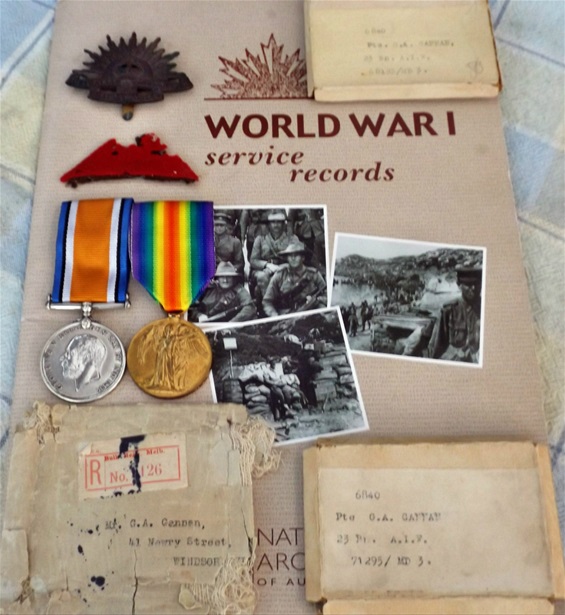 Gerald Allan Gannans' Service Record, Hat Badge, part Shoulder Flash and Medals plus the original package the medals came in.
Gerald Allan Gannans' Service Record, Hat Badge, part Shoulder Flash and Medals plus the original package the medals came in.
Gerald Allan Gannan
Gerald was Jims young brother. He was known as Allan, probably because his Dads name was also Gerald. For the rest of this section He shall be refered to as Allan. Allan served
for 12 months in the Citizen Forces before enlisting in the AIF on 8 Jun 1917. On that day he was allocated the Regimental Number 6840. After departing the Enlistment Area at the Melbourne Cricket Ground 6840 Private G.A. Gannan reported to the Broadmeadows
Army Camp to be allocated to a unit for training and was posted to the 20/23 Reinforcements. Whilst at Broadmeadows Allan went through the various training activities of an Infantryman to suit him for the posting at 23 Battalion Australian Imperial Force.
On 21 Nov 1917, along with the other reinforcements Pte G.A. Gannan embarked upon the HMAT Nestor and sailed towards North Africa. Nearly a month later, 15 Dec 1917, this group of soldiers disembarked at Suez and moved to Australia Camp Suez to
prepare for the Trip to France. From here the record is somewhat jumbled. The next time the reinforcements moved was by HMT Abbasse which left Suez on 5 Jan 1918 and disembarked at Taranto, a Naval Base, in
Italy. They were there for a couple of days and once again disembarked on 23 Jan 1918. His record does not say where they disembarked but suggests that the next stop was at a place called Fovant, in England, near Salisbury, where he marched into the
6th Training Battalion. Here, his record was updated due to a duplication of service numbers and Allan had an "A" added to his number. The next couple of entries add to the confusion, on 15 April Allan moved to France
from Folkstone and on 17 April he moved to the New Zealand Base Depot from England. Then, finally, he was taken on strength of 23 Battalion AIF on 20 April 1918. On 20 May Pte GA Gannan was Wounded In Action with a schrapnell would to the Right Side
of his Chest. He was obviously evacuated from the battle field for treatment and rehabilitation and eventually rejoined his unit in France on 28 Sep 1918. The next entry says he Returned To Australia on 10 April 1919, and discharged on 14 July 1919.
If anyone has further information on this soldier or his unit I would like to hear about it. I shall ferret away at the various archives and books available and shall adjust this record as appropriate.
|
|
 |
|
|
|